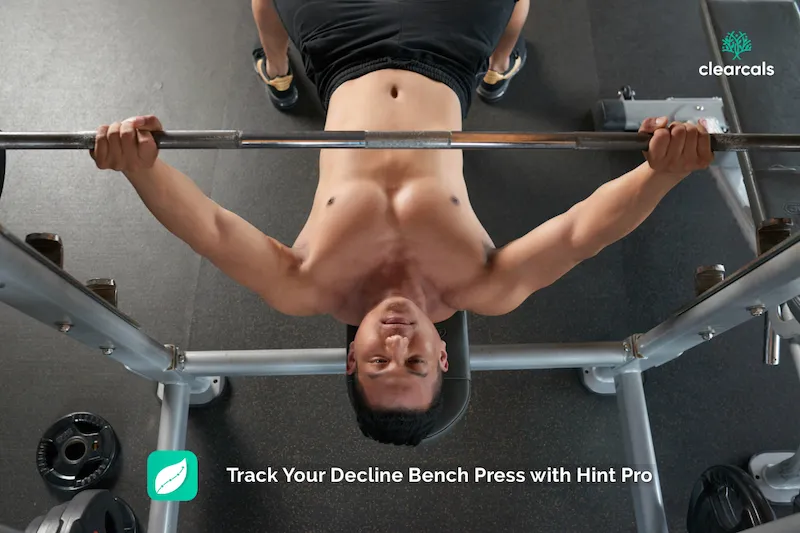Looking for a Personalized Diet Plan?
Decline Bench Press: Build a Strong Lower Chest

By Dr. Krishna Athmakuri, Co-Founder & CEO of Clearcals
The decline bench press is an excellent exercise for targeting the lower portion of the pectoral muscles, helping you build a well-rounded, defined chest.
It’s often overshadowed by the flat and incline bench press, but adding the decline bench press to your routine can ensure balanced muscle development across the chest and shoulders.
In this blog, we’ll explore how to perform the decline bench press, which muscles it works, and the benefits of different variations.
With the Pro Workouts feature available through the Hint app, you can easily track your progress in the decline bench press and other key exercises.
The Hint Pro and Hint Premium subscriptions offer personalized support to help you meet your fitness goals through advanced workout tracking and nutrition planning.
How to Do Decline Bench Press
Here’s a step-by-step guide on how to do the decline bench press correctly for maximum muscle engagement and safety:
- Set Up the Decline Bench: Position yourself on a decline bench that allows your feet to hook into the foot pads for stability. Adjust the bench to a decline of about 15-30 degrees.
- Grip the Barbell (or Dumbbells): If using a barbell, grab it with an overhand grip, slightly wider than shoulder-width. For dumbbells, hold one in each hand with palms facing forward.
- Lower the Weight: Slowly lower the barbell or dumbbells toward your chest, keeping your elbows at a 45-degree angle. Focus on lowering the weight in a controlled manner to engage the lower chest.
- Press the Weight Up: Push the weight back up to the starting position by extending your arms. Avoid locking out your elbows at the top to keep the tension on your chest and triceps.
- Maintain Form: Keep your lower back pressed into the bench, and ensure your feet remain stable in the foot pads to maintain balance.
Decline Bench Press Muscles Worked
The decline bench press primarily targets the lower pectoral muscles (pectoralis major).
By positioning your body at a downward angle, the decline press emphasizes the lower part of your chest, which can be harder to target with other bench press variations.
In addition to the lower chest, the decline bench press also engages:
- Triceps: Essential for pushing movements, the triceps are heavily activated in the decline bench press.
- Anterior Deltoids: The front part of the shoulders helps stabilize the movement and provide pressing power.
- Serratus Anterior: Located near the ribcage, this muscle assists in the overall movement and control of the barbell or dumbbells.
Including the decline bench press in your routine ensures that your chest muscles develop evenly, preventing imbalances and enhancing overall upper body strength.
Decline Bench Press Angle
The ideal decline bench press angle typically ranges between 15 to 30 degrees. This slight downward angle helps target the lower part of the chest more effectively by altering the direction of the push.
A steeper decline (closer to 30 degrees) puts more emphasis on the lower pectoral muscles, while a shallower decline (around 15 degrees) balances the load between the chest and shoulders.
Using the right decline angle ensures maximum engagement of the chest muscles while minimizing strain on the shoulders, making it an essential factor for proper form and muscle development during the exercise.
Decline Barbell Bench Press vs. Decline Dumbbell Bench Press
There are two primary ways to perform the decline bench press—using a barbell or a dumbbell. Each variation has unique benefits:
- Decline Barbell Bench Press: This variation allows you to lift heavier weights and engage both arms simultaneously. It’s ideal for building maximum strength in the chest and triceps.
- Decline Dumbbell Bench Press: Using dumbbells increases the range of motion, which activates more stabilizer muscles and allows each arm to work independently. This is a great option for those looking to improve muscle balance and control.
Both the barbell and dumbbell versions are effective, and including both in your routine can provide a well-rounded chest workout.
Decline Bench Press Benefits
The decline bench press is an effective exercise for building lower chest muscles, offering several key benefits:
- Targeted Chest Development: By positioning the bench at a decline angle, this movement specifically engages the lower pectoral muscles, helping to create a more defined and balanced chest.
- Increased Strength and Power: Regularly incorporating the decline bench press into your routine can enhance overall upper body strength and improve performance in other pressing movements.
- Reduced Shoulder Strain: The decline angle shifts the focus away from the shoulders, making this variation easier on the shoulder joints while still providing a robust chest workout.
- Improved Muscle Activation: The decline position allows for a greater range of motion compared to flat or incline presses, leading to better muscle engagement and hypertrophy.
For optimal results, combine the decline bench press with other chest exercises in your strength training routine.
Decline Bench Press Alternative
If you don’t have access to a decline bench or want to try different movements, several decline bench press alternatives target similar muscles:
- Chest Dips: This bodyweight exercise also targets the lower chest and triceps, making it an excellent substitute for the decline bench press.
- Push-Ups with Feet Elevated: Elevating your feet while performing push-ups mimics the angle of the decline bench press, targeting the lower chest.
- Cable Crossovers (Low Pulley): Using cables set at a low angle can simulate the decline bench press by activating the lower pectorals during the pressing motion.
These alternatives can complement your routine and help target the lower chest without the need for a decline bench.

Pro Workouts and the Hint App
With the Hint app’s Pro Workouts feature, available exclusively to Hint Pro and Hint Premium subscribers, you can log your sets, reps, and weights for exercises like the decline bench press.
The app allows you to track over 300 different exercises, including variations like the decline barbell bench press and decline dumbbell bench press, ensuring you stay on track with your strength goals.
In addition to workout tracking, the Hint app provides personalized diet plans to help fuel your training.
Whether you’re focused on muscle gain or fat loss, Hint Pro offers detailed insights into your nutrition, while Hint Premium gives you access to unlimited consultations with expert dietitians for tailored advice.
Conclusion
The decline bench press is an essential exercise for developing the lower chest, helping you achieve a more balanced and defined upper body.
Whether you use barbells, dumbbells, or machines, this movement ensures you’re working all parts of the chest for maximum strength and aesthetic benefits.
By incorporating the Pro Workouts feature on the Hint app, you can monitor your progress, log your workouts, and track your calorie burn.
Combined with personalized nutrition plans available through Hint Pro and Hint Premium, you’ll have all the tools you need to achieve your fitness goals.
About the Author
Dr. Krishna Athmakuri is the Co-Founder and CEO of Clearcals, where he leads the development of data-driven health technology through the Hint app.
With a Ph.D. in Chemical Engineering from Rensselaer Polytechnic Institute, New York, his expertise spans analytics, protein chemistry, and biotechnology.
Earlier in his career, he developed biotherapeutics for diabetes and metabolic diseases at companies like Aurobindo Pharma and Dr. Reddy's Laboratories.
At Clearcals, he now applies that scientific rigor to build personalized fitness tools, including Hint Pro Workouts, nutrition tracking, and real-time metabolic insights — helping users make smarter health decisions through technology.
🔗 Connect with Krishna on LinkedIn





